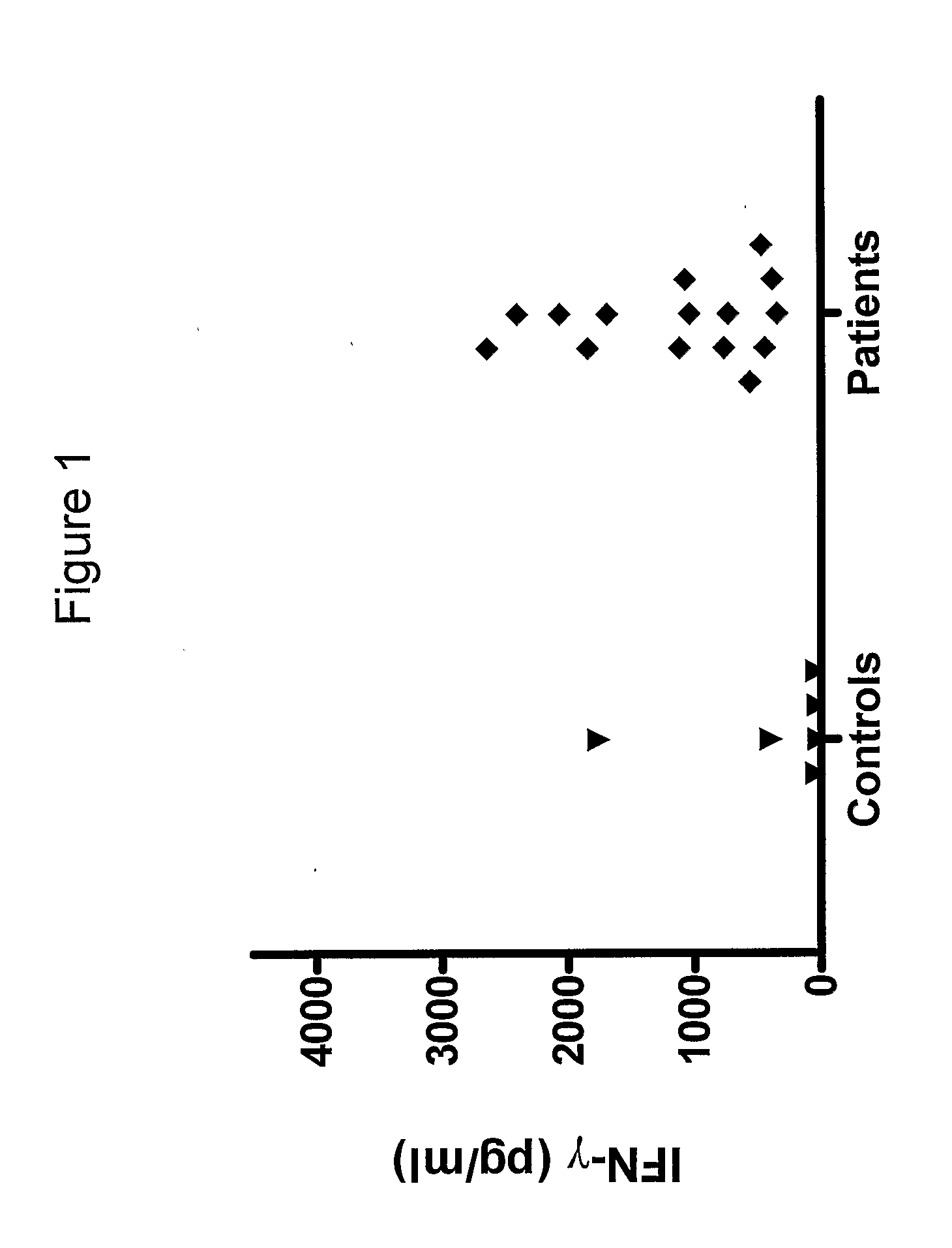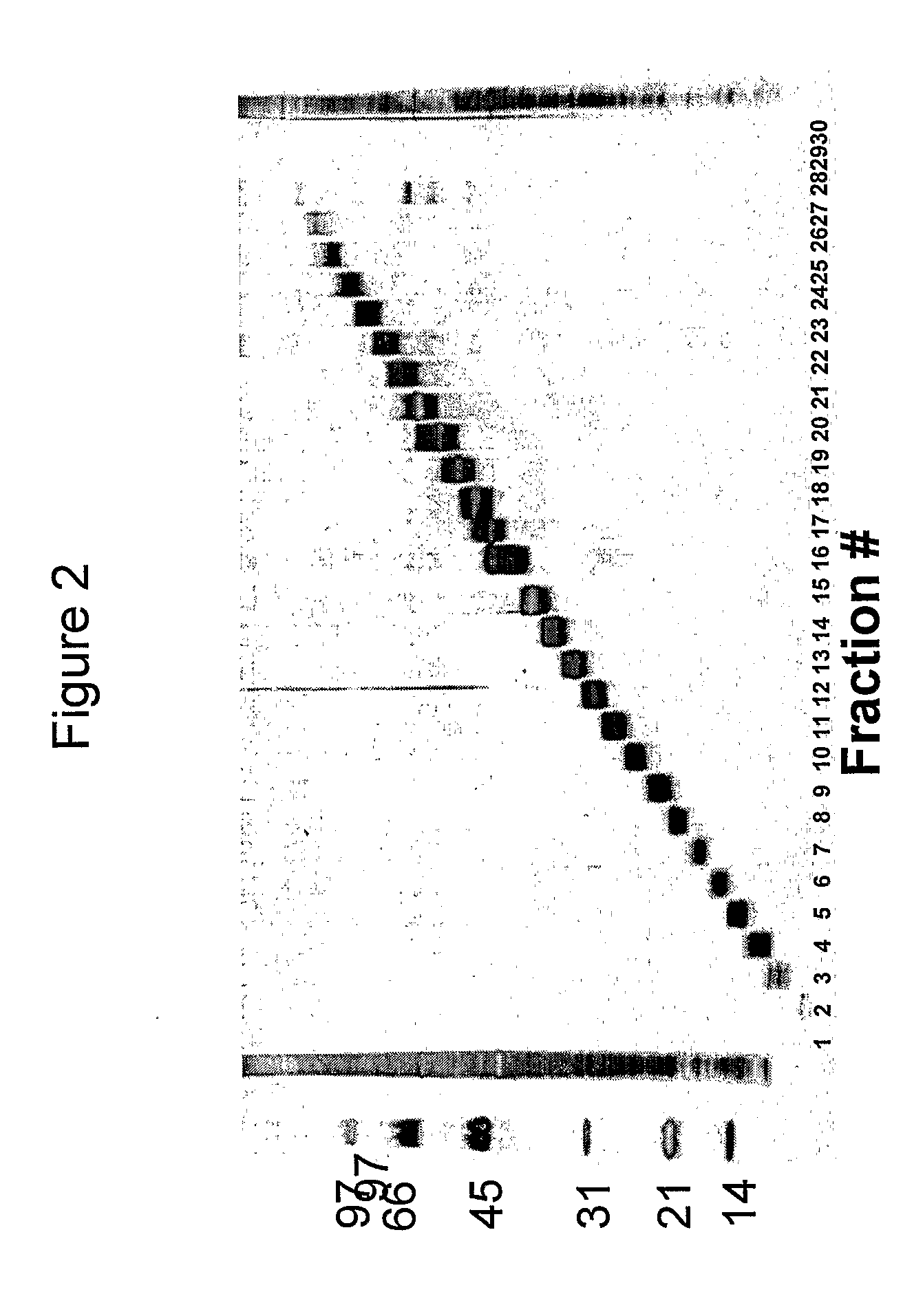Chlamydia trachomatis antigens for vaccine and diagnostic use
a technology of chlamydia trachomatis and antigens, which is applied in the direction of chlamydia trachomatis ingredients, snake antigen ingredients, carrier-bound/immobilised peptides, etc., can solve the problems of inability to sustain i>chlamydia /i>control, no vaccine has been developed, and the demonstration of a specific long-term protective immune response has not yet been achieved
- Summary
- Abstract
- Description
- Claims
- Application Information
AI Technical Summary
Benefits of technology
Problems solved by technology
Method used
Image
Examples
example 1
Identification of Human T Cell Antigens of C. Trachomatis Serovar D Introduction
[0125]We have analysed the human T cell responses to C. trachomatis proteins using narrow molecular weight fractions derived from complex protein mixtures separated by SDS-PAGE followed by electroelution. This technique enable direct analysis of the immune response and making comparison of stimulatory protein fractions possible. This has led to the identification of a number of stimulatory protein fractions and identification of T cell targets. Further evaluation of these T cell targets have been done using recombinant technologies and overlapping peptides spanning the entire sequence of the protein.
Materials and Methods
Microorganism and Cultivation
[0126]C. Trachomatis serovar D (strain UW-3 / Cx) was propagated in Hela 229 cells (ATCC, Rockville, Md., USA). The cells were cultivated in passage medium RPMI 1640 (Gibco BRL, Grand Island, N.Y., USA) containing 5% fetal calf serum (Gibco BRL; heat inactivated...
example 2
Directed Library Strategy (Screening for Antibody Targets)
Introduction
[0144]A High Throughput approach was taken to test for serum reactive antigens in the C. trachomatis serovar D genome. A full length library was constructed of the first 200 Open Reading Frames (ORFs). This library was designed to express the antigens recombinantly in Escherichia coli. For screening of this library, we used a pool of serum from 5 high responding patients which were selected based on their reactivity towards a whole C. trachomatis Elementary Body (EB) extract by Western blot analysis.
Materials and Methods
Construction of Full Length Library
[0145]The genome of C. trachomatis serovar D is publicly available and the primary annotation was used as defined by Stephens et. al. (Stephens, Kalman et al. 1998). Genes Ct001 to Ct200 was selected for cloning. 5′, and 3′ primers for amplification of the specific genes was designed by a “in house” software. The full length sequences of the 200 specific C. tracho...
example 3
Random Library Strategy
Introduction
[0160]In order to screen for serum reactive antigen in the C. trachomatis serovar D genome, a random expression library was constructed in the expression vector % gt11. This library was designed to express randomly C. trachomatis peptide fragments of 100-400 amino acid residues fused inframe with the β-galactosidase. The library was screened with serum from patients which were selected based on their reactivity towards a whole C. trachomatis Elementary Body (EB) extract by Western blot analysis.
Materials and Methods
[0161]Isolation of High Molecular Weight C. trachomatis Serovar D Genomic DNA.
[0162]A crude C. trachomatis serovar D elementary body preparation containing ˜8.6×109 IFU (infectious units) was further purified by 44-54% Diatrizoate solution step density gradient ultracentrifugation at 40.000×g for 60 min. The elementary bodies banded at the 54% interface were collected, diluted in 10 volumes SPG buffer (250 mM Sucrose; 10 mM Na2HPO4; 5 mM...
PUM
| Property | Measurement | Unit |
|---|---|---|
| temperature | aaaaa | aaaaa |
| concentration | aaaaa | aaaaa |
| diameter | aaaaa | aaaaa |
Abstract
Description
Claims
Application Information
 Login to View More
Login to View More - R&D
- Intellectual Property
- Life Sciences
- Materials
- Tech Scout
- Unparalleled Data Quality
- Higher Quality Content
- 60% Fewer Hallucinations
Browse by: Latest US Patents, China's latest patents, Technical Efficacy Thesaurus, Application Domain, Technology Topic, Popular Technical Reports.
© 2025 PatSnap. All rights reserved.Legal|Privacy policy|Modern Slavery Act Transparency Statement|Sitemap|About US| Contact US: help@patsnap.com



